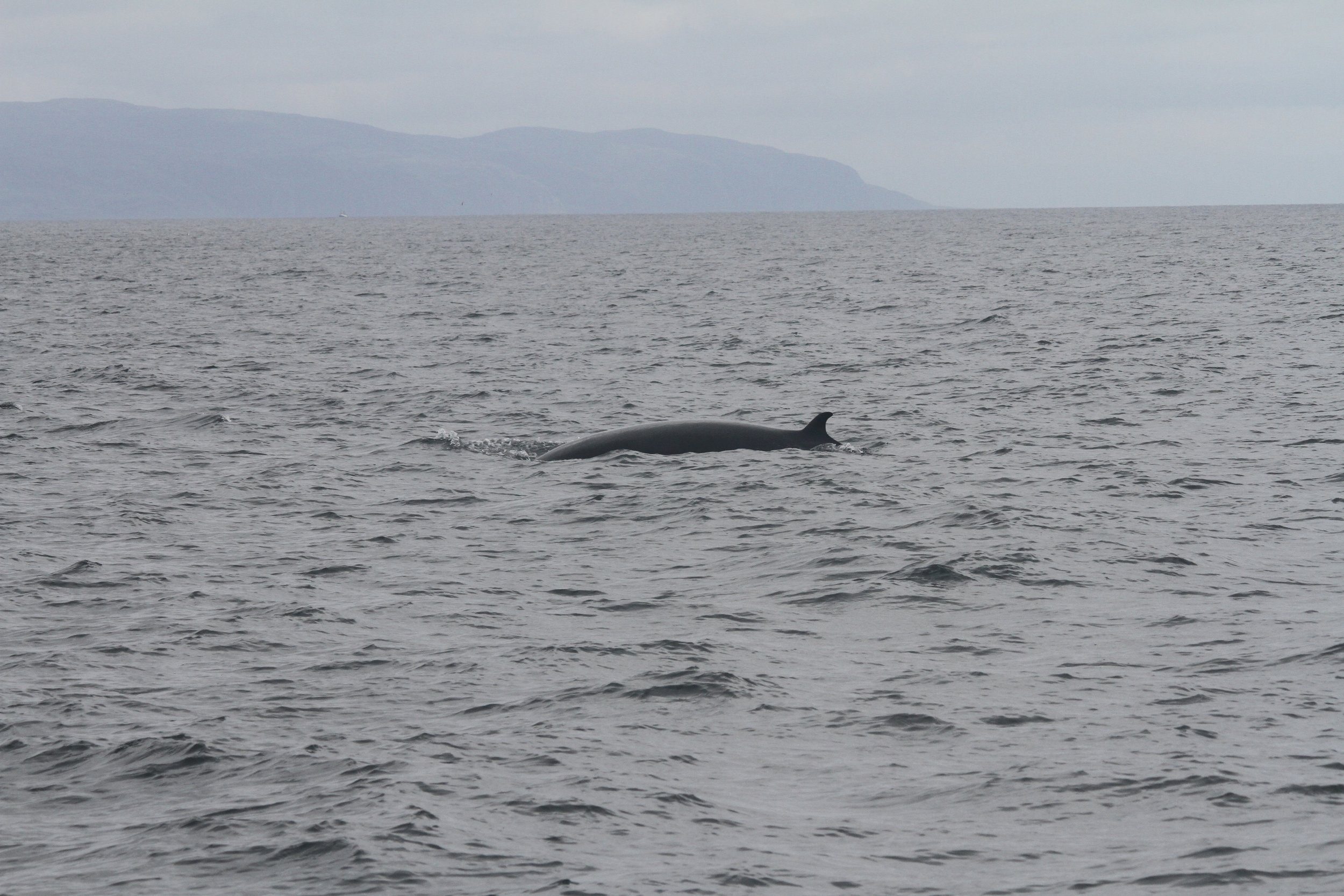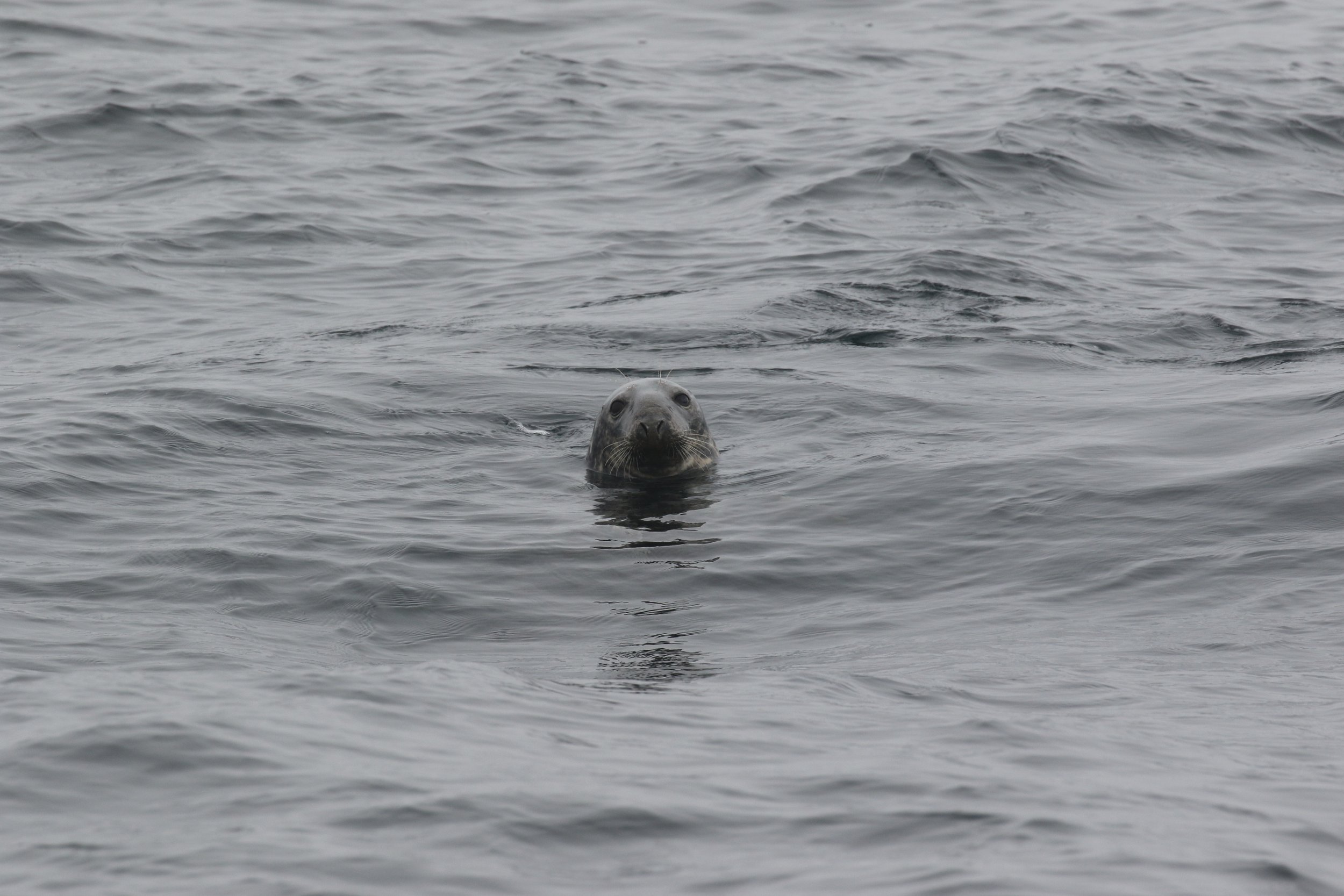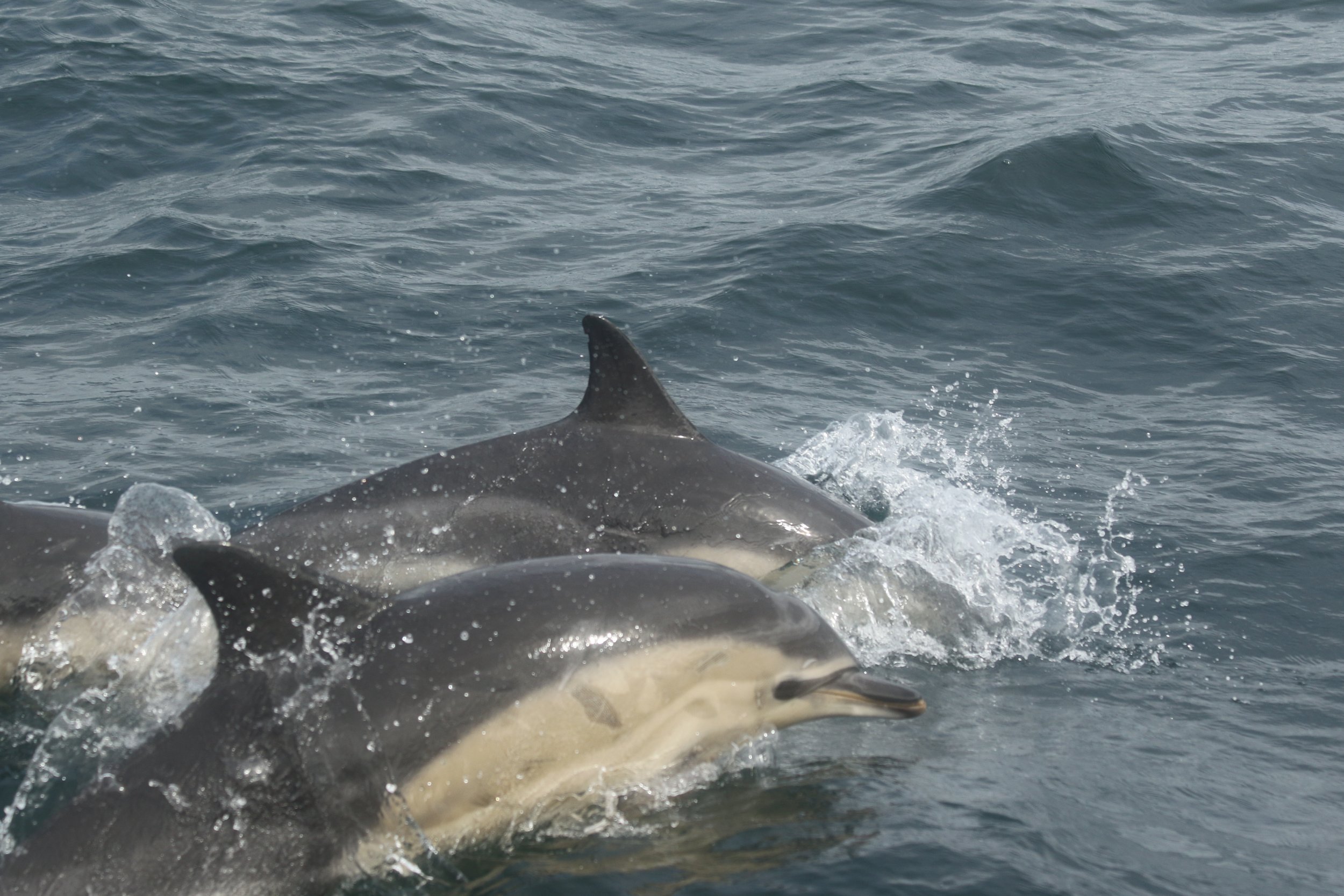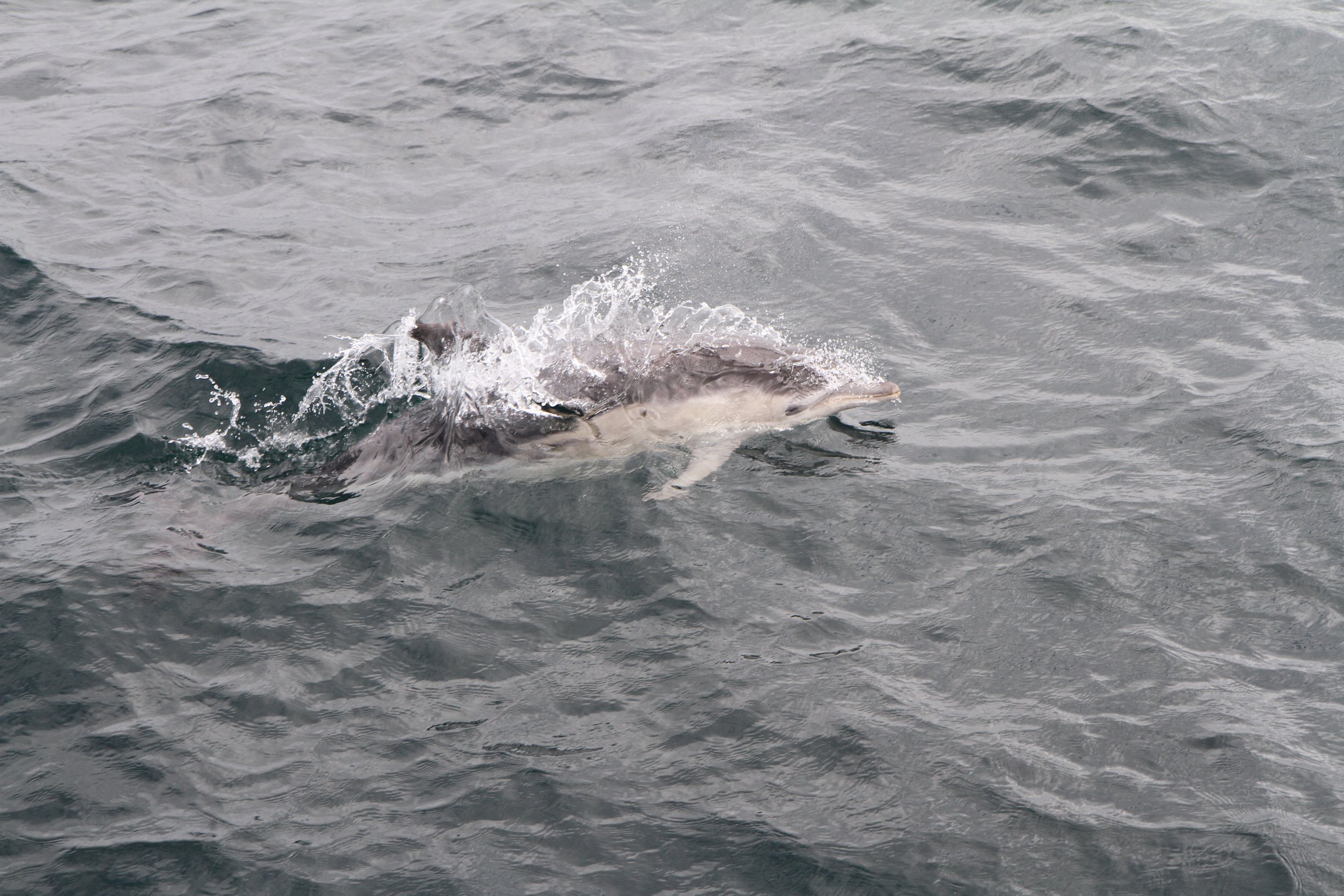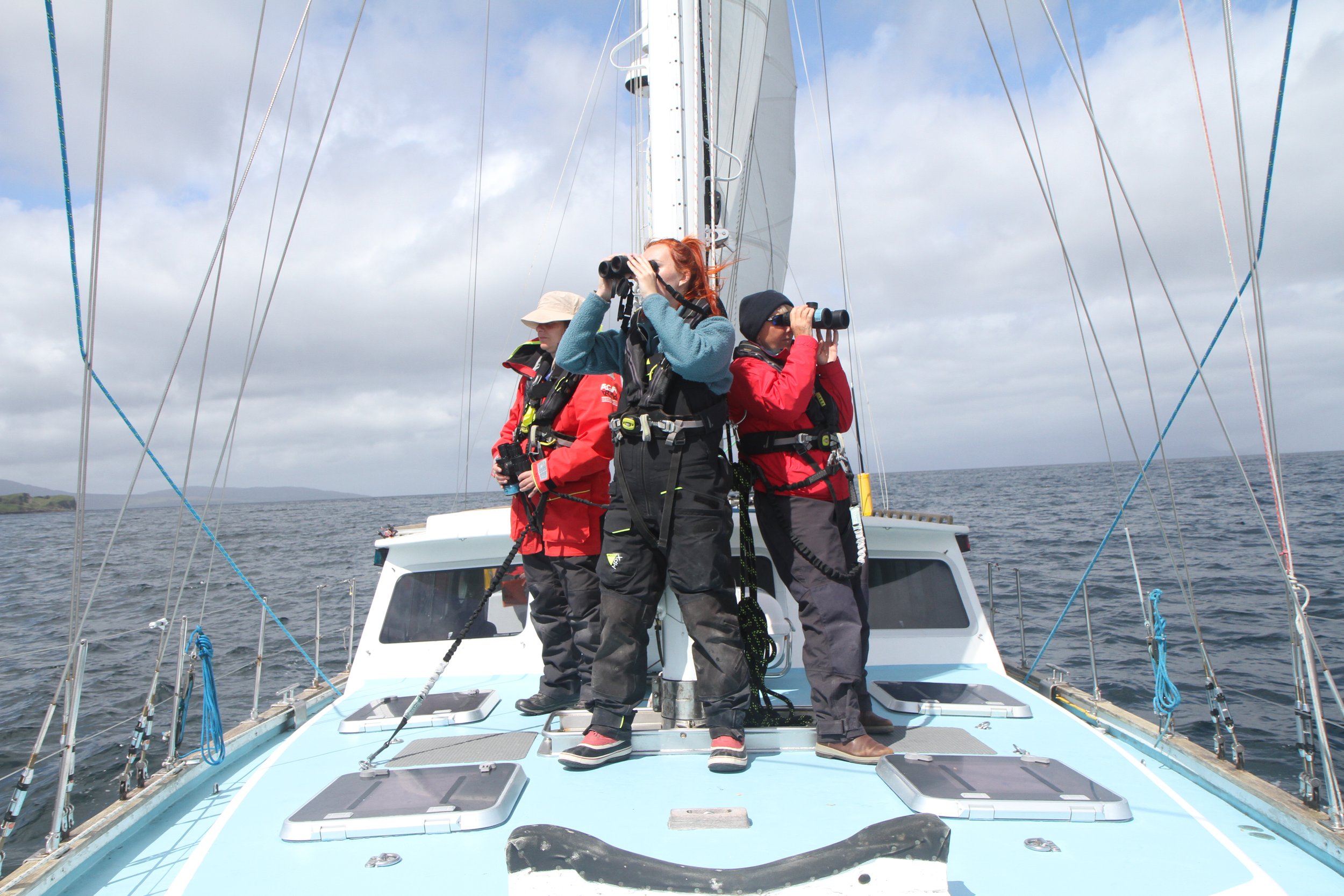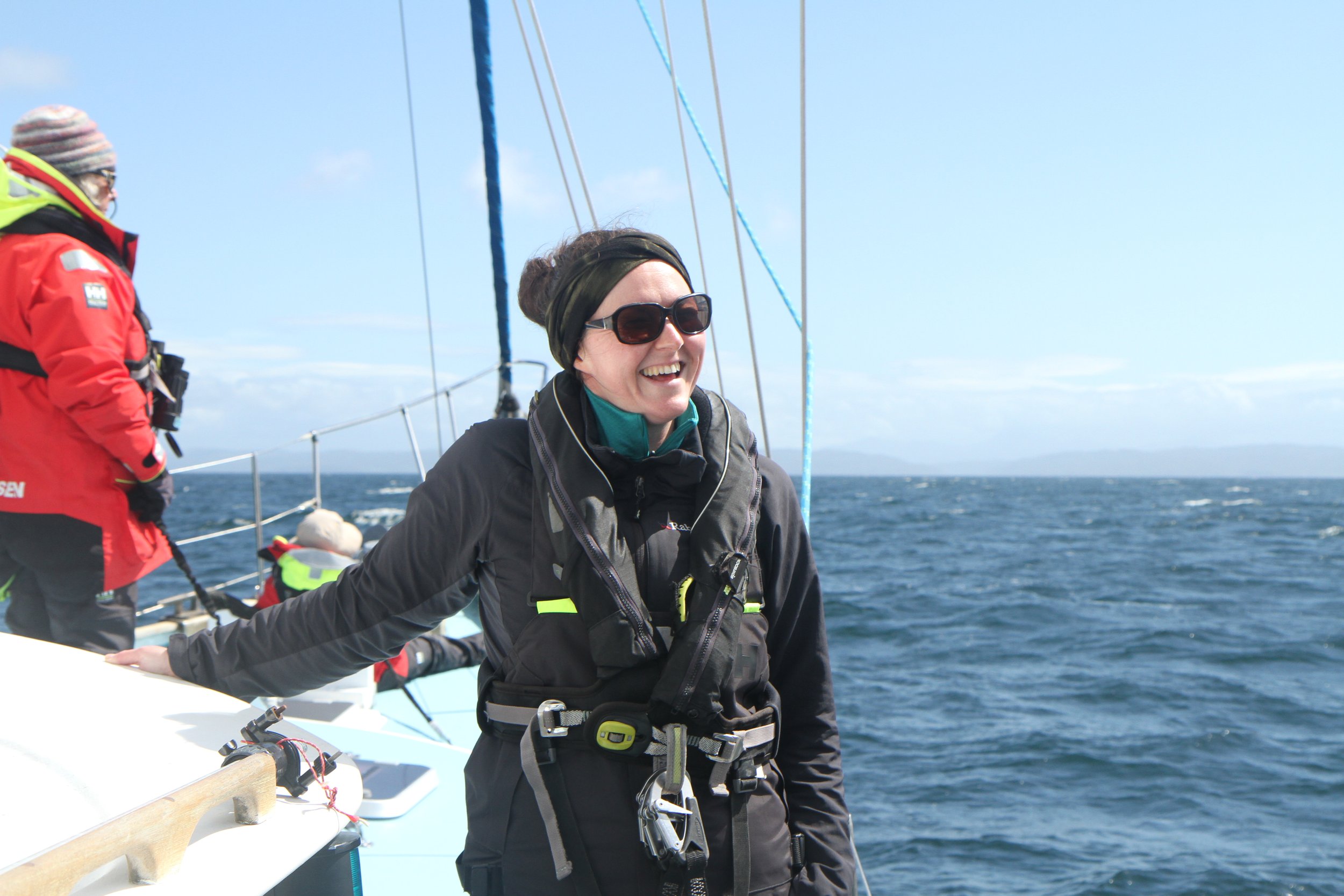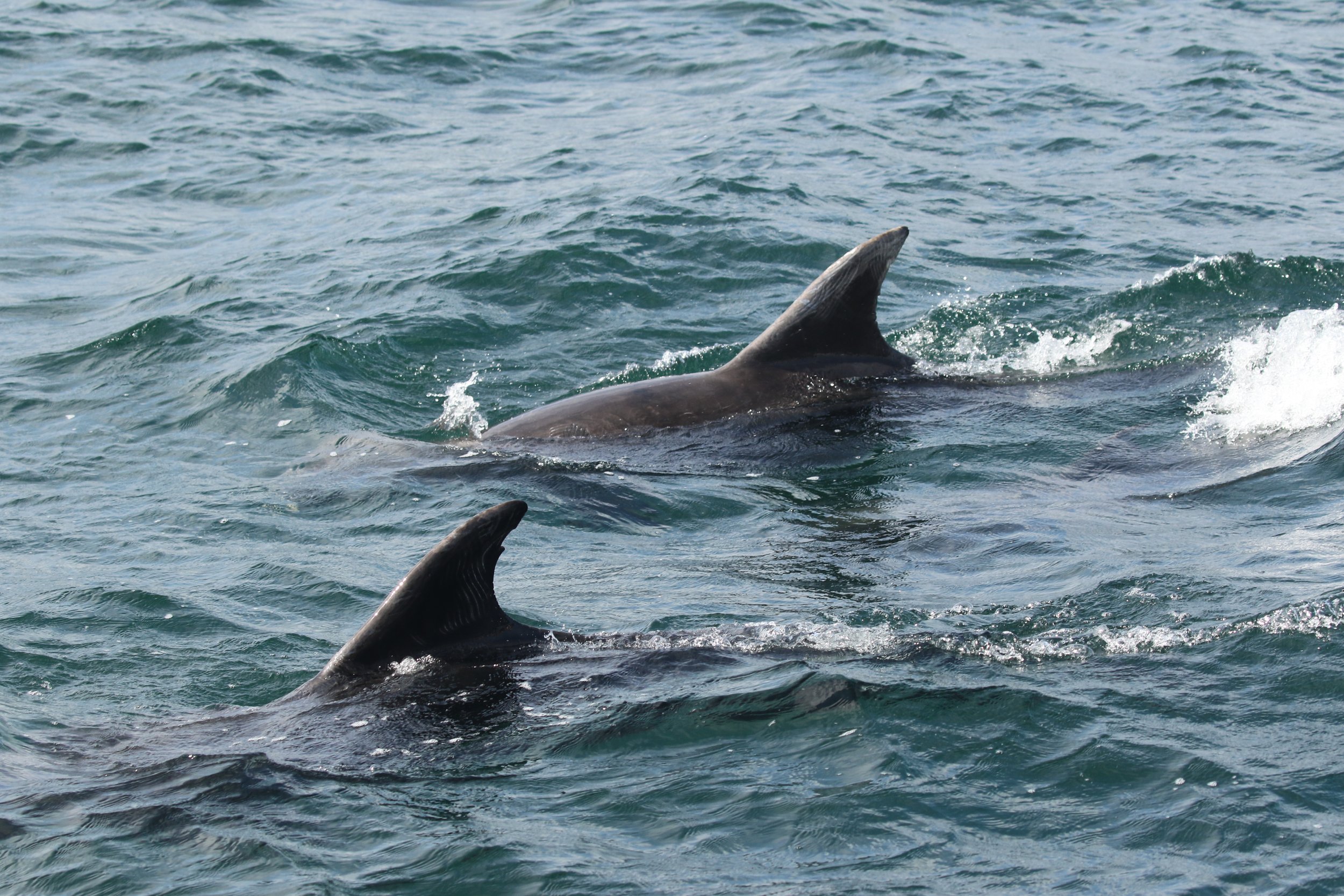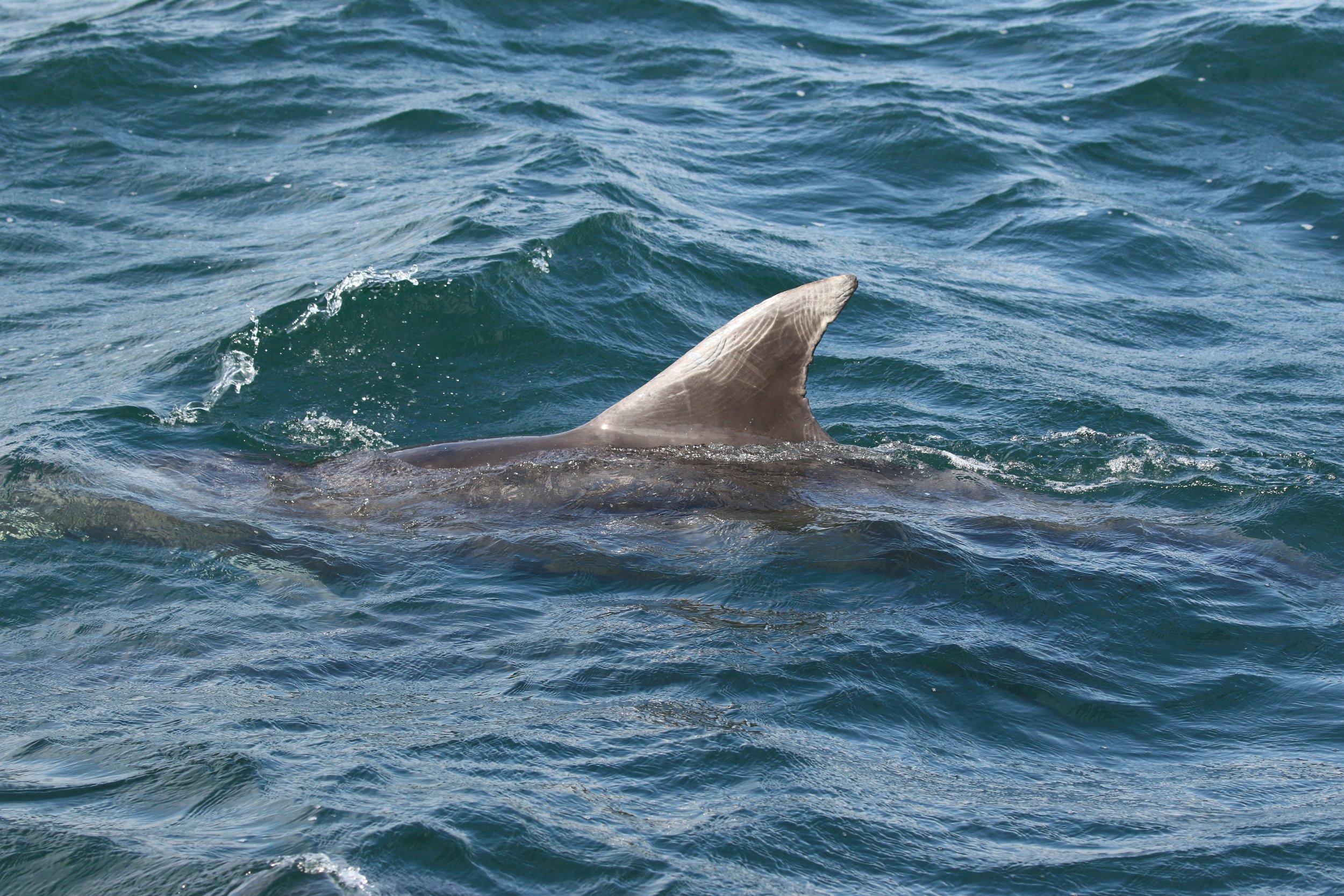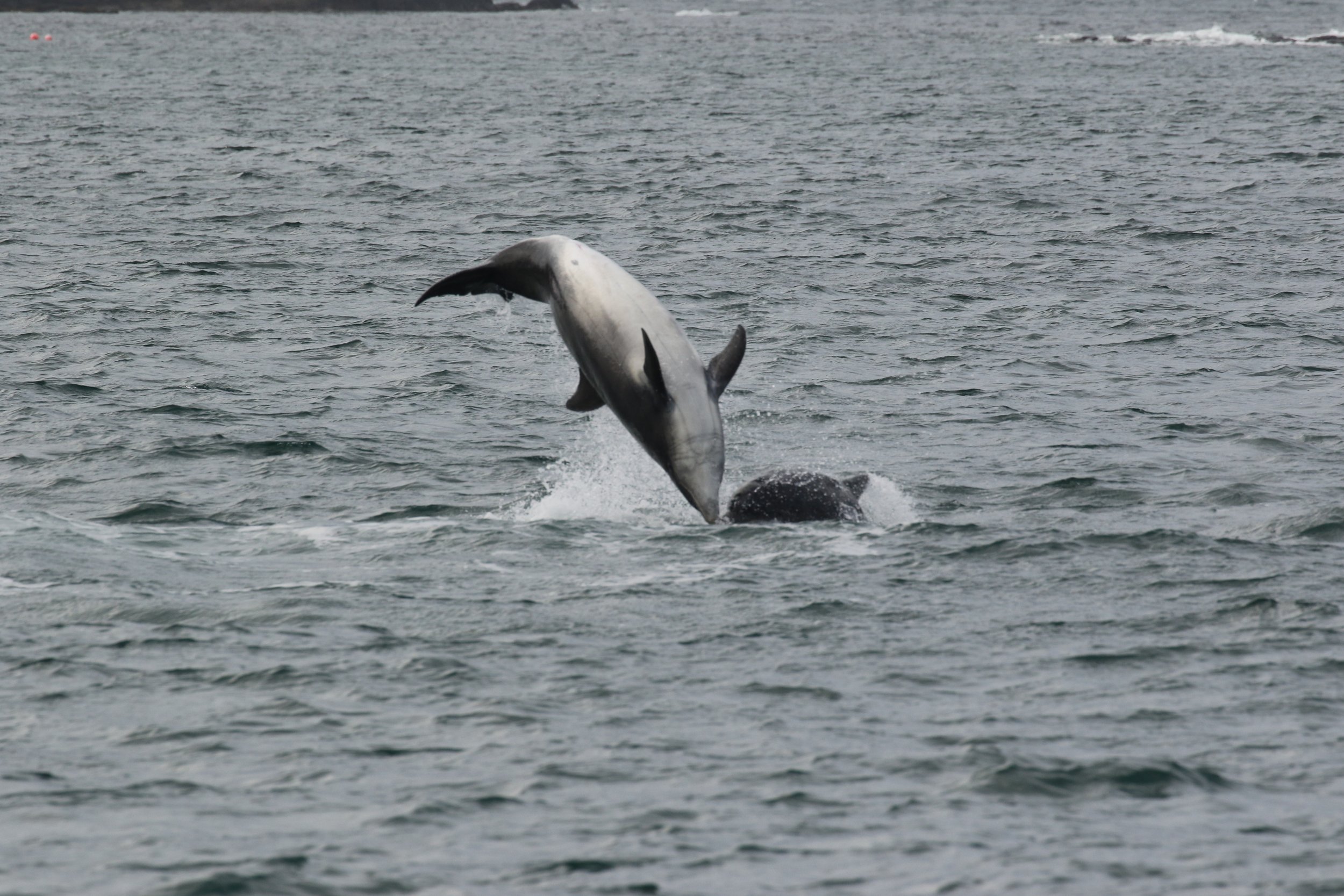Swell, seas and surprise sightings onboard Silurian during eighth research expedition
MARKING THE MIDDLE OF THE SUMMER 2022 RESEARCH EXPEDITIONS, SILURIAN - OUR RESEARCH VESSEL - SET SAIL FROM TOBERMORY MONITORING HEBRIDEAN SEAS. TRICKY WEATHER CONDITIONS CONTINUED, BUT OUR TEAM OF VOLUNTEER CITIZEN SCIENTISTS POWERED THROUGH TO HELP GATHER VITAL VISUAL AND ACOUSTIC DATA AND WERE REWARDED WITH SOME INCREDIBLE ENCOUNTERS. HERE HANNAH LIGHTLEY, SCIENCE OFFICER ON BOARD, SUMMARISES THE EXPEDITION…
DAY 1 + 2
Citizen scientists Caren, Vincent, Pam, CeCe, Delia and Alison joined the crew in colourful Tobermory for the start of HWDT08, a 12-day trip surveying the west coast for marine mammals. Once settled on board, the evening was spent getting to know one another, learning more about HWDT and the marine mammal species encountered off the west coast, as well as an in-depth demonstration of how to use the heads!
The next morning following a safety briefing and survey training, the group set sail towards the Cairns of Coll in the sunshine. With a half-meter swell and a bit of wind, we recorded a great skua, lots of guillemots, and some puffins – a delight for all onboard. After a few hours surveying the Sea of the Hebrides, we made a course change to head back towards the Isle of Mull, towards Caliach Point. Travelling northwest along the coast of Mull towards Ardnamurchan Point and into the mouth of Loch Sunart, many creels were spotted, allowing the volunteers to practice distance estimation in preparation for all the marine mammals we would hopefully see during the rest of the trip. After many creel sightings, we headed towards our anchorage for the night in Loch Na Droma Buidh just as the slight rain started coming down.
DAY 3
Conditions of light drizzle and a grey overcast sky started our day in Loch Na Droma Buidh. After breakfast we prepared for the strong winds that were expected on leaving the sheltered loch and during the passage down towards the Sound of Mull.
Having passed through the narrow loch entrance, the depth was sufficient to deploy the hydrophone and surveying started, albeit in not ideal conditions. After about an hour of surveying we were in the Sound of Mull and sheltered from the strong southwestern winds. Grey overcast skies and a constant drizzle made the visual surveying challenging at times, but did not dampen the spirits of those onboard who were eager for a cetacean sighting. The strong winds did however allow for some sailing, yielding uninterrupted acoustic recordings, free from Silurian’s motor noise in the background. Despite the poor surveying conditions, harbour porpoise - the UK’s smallest cetacean - were spotted on three occasions. Some great spotting in tricky conditions.
A rather unexpected sighting was a large military vessel present in the Sound of Mull conducting personnel training exercises. As the weather began to deteriorate further, the final 90 minutes of surveying were conducted in the Firth of Lorn. Strong winds and rough seas lead to an entertaining transit, ending in Loch Spelve, before the slightly shorter workday reached its end.
DAY 4
Leaving our anchorage, the sun shone through the break in clouds. A welcome sight as we waved to Emma (HWDT’s previous skipper and boat manager) aboard the Flying Dutchman - she had also taken shelter in Loch Spelve that night.
Once out of the loch and into the Firth of Lorn surveying started with a single harbour porpoise spotted within the first 15 minutes, a hopeful sign of good things to come. Sadly, weather conditions continued to deteriorate as the day went on with visibility sometimes as low as ¼ mile but thankfully the sea state remained mostly calm. Brief sightings of porpoises and a probable minke were spotted by a volunteer on mast but were not seen by anyone else. With tide against us and the sea state becoming choppier, our destination changed from Tiree to Colonsay allowing survey work to be conducted in an area not yet surveyed this season including crossing a depth change of 100m.
Suddenly ‘SIGHTING’ was shouted by Pam on mast left followed seconds later by ‘SIGHTING’ from Ally on mast right. Following the survey protocol to only call sightings in your section Pam turned to Ally questioning why she had called a sighting on her side, but Ally had her own whale – RESULT! ‘With Whale’ was shortly called by Science Officer Hannah to try and get photo ID shots of the dorsal fins. Returning to the transect line, later another harbour porpoise was spotted and a bottling grey seal, which was the first pinniped sighting of the trip.
Our eventual destination was Oronsay, a lovely tidal island to the south of Colonsay and after a long 8 hour day we were ready for a bit of down time. Half of the volunteers braved the cool waters and went for a swim, whilst others went to shore for a short beach walk. The haar descended whilst folks were exploring the beach and Silurian slowly disappeared into the mist – very atmospheric and spooky. Back aboard, we enjoyed a delicious meal of frittata and spicy curry followed by an interesting discussion about whale acoustic research.
DAY 5
Up early and ready for our second day of attempting to reach Tiree, we were ‘On Effort’ for 08.30am. Soon after leaving Oronsay, the mist and drizzle returned, and the weather began to worsen. Within an hour the swell was reaching 2 metres making it increasingly difficult to stay stood upright on the mast. Hannah called ‘Off Effort’ and the decision was made to turn around and return to the sheltered waters of the islands. We continued ‘Acoustic Only’ survey effort, managing to conduct listening stations below deck.
The weather calmed some as we travelled back to Colonsay and Oronsay, and after about an hour the conditions settled enough for the team to go back ‘On Effort’. Although it was still a bit rough we had some fabulous bird sightings with a ‘hurry’ of around 20 gannets along with many Manx shearwaters, gulls, kittiwakes, guillemots, a great skua and razorbills. Even with all this bird activity we sadly did not see any cetaceans, but we did record two sightings of grey seals. Eventually, after much hard work by both volunteers and crew we ended up exactly where we started in a beautiful small bay off Oronsay by 5pm.
Most people by this time needed a nice hot shower, a treat after a hard day’s work at sea. As we are trying to conserve as much water as possible some took a shower aboard whilst some others took the dinghy to the beach and took a ‘sea bath’. Our tummy’s full of delicious Quorn shepherd’s pie, everyone was ready for an early night in preparation for attempt number three of heading to Tiree tomorrow.
DAY 6
Today was the day, we were heading to Tiree! Hannah started the morning by playing hype songs through the boat’s speaker, getting the team pumped for our voyage into open water. Heading north towards Balnahard, we were able to deploy the hydrophone and begin gathering acoustic and visual data early in the day. Travelling further north, the sea remained calm with only small wavelets present - ideal conditions for spotting cetaceans. Once we had reached the most northerly point of Colonsay, we headed west past the Ross of Mull and onto our straight transect to Tiree. We began passing bird raft after bird raft and there was a feeling in the air that we were going to soon come across our first sighting! ‘MINKE WHALE’ was heard from the mast closely followed by Hannah shouting ‘With Whale’ – our first sighting of the day! The minke whale slowly surfaced less than 200 metres from the boat allowing everyone to hear the blow and get a good view of the back and dorsal fin. This minke stayed close by, 100-500 metres from the boat, allowing Hannah and Ally to collect good ID pictures of the dorsal fin. Starting to travel back to the transect line, two more minkes were spotted in the distance. Clearly, we had stumbled across a productive area with plenty of opportunities for foraging. Gathering further photos of these two animals it was thought that it may have been an adult and sub-adult/juvenile pair with one animal significantly smaller than the other. We couldn’t believe our luck; three separate minke whales within the same hour.
Delighted with our efforts we headed towards Tiree and we continued to have calm seas allowing further sightings of four grey seals and one harbour porpoise. Just as we caught a glimpse of Tiree, we heard an excited shout of ‘SIGHTING!’ from above deck. We finally had our first dolphin sighting of the trip, a small group of common dolphins who came to check out Silurian for a few minutes before heading back off into open water.
Our very successful day ended as we made our way towards Gott Bay on Tiree. With Hebridean music in the background, we dropped anchor and had a big cheer from everyone on board for finally making it to Tiree. Some headed ashore to have an explore and to try and spot some bands heading to Tiree Music Festival, whilst others headed to the beach for a sea swim. Gathered around the saloon table, we spoke about our favourite sighting of the day and shared a real sense of achievement of being able to head into open water and correctly ID many marine mammal species.
DAY 7 + 8
Leaving our anchorage at Tiree we were accompanied by misty skies as we travelled towards Gunna Sound in hope of spotting a basking shark. Travelling through Gunna Sound yielded great joy, albeit no shark sightings, due to the vast number of shags spotted and interesting tidal movement through the narrow body of water. Once through the sound, the sea became a little choppier as we headed to the Outer Isles. Blue skies popped in and out of the clouds whilst we motored across the Sea of the Hebrides spotting a 14 grey seals along the way.
Reaching Barra Head, the sun finally came out of the clouds as we saw the southern outer islands in beautiful light. We travelled along the east coast further north towards Barra. That is when we spotted our first common dolphins of the day leaping energetically out of the water in all directions before spotting Silurian. There were at least 12 common dolphins that headed straight for the bow and began to bow ride – a behaviour we had been waiting for all week! There were tears of joy and shrieks of excitement from the volunteers as the dolphins travelled with us, bow-riding and interacting with Silurian. With the sun still shining and the team still riding the high of the last dolphin encounter, we continued to cruise north and stay ‘On Effort’ for an extra hour. This helped to compensate for the shorter days we had due to rough weather and it certainly paid off as we had a further two encounters of common dolphins.
The next morning we set sail and headed further North towards South Uist. The dramatic coastline of the Outer Isles continued to delight all those onboard. This was the furthest west many had ventured before. Another long day provided sightings of one habour porpoise, two common dolphin encounters and three grey seal sightings. Our anchorage for the evening was Loch Eynort, our own little bit of paradise, so remote we didn’t have any phone signal – pure bliss! The evening was spent enjoying a three-course meal, having showers on deck and playing games including Silurian’s favourite ‘Pass The Pigs’ where some even managed to get a leaning jowler.
DAY 9
Waking up in Loch Eynort was one of the most beautiful anchorages on this trip. The rugged surroundings, devoid of any signs of civilization, made for a stunning panorama. Whilst having our breakfast, a white-tailed eagle flew right by Silurian in all its beauty allowing everyone to run up on deck and enjoy this early morning surprise sighting. Excited for the day we headed out of the loch and into open sea; conditions were calm and peaceful making a pleasant start to the day. Swell however started to increase, and two minke whales were spotted amongst the waves. Sadly, we only managed to catch a glimpse of the whales between the chop.
We were however treated to an encounter with a pod of common dolphins a few hours later that provided every photo opportunity we could have dreamed of. The final transects of the day lead us through the channel between Rum and Canna. Here we had stunning views of the rough coasts of both islands. Arriving at our anchorage, the rest of the evening was spent ashore at Canna where crew and volunteers stretched their legs and enjoyed the delights of the community shop as well as visiting some of the tourist hotspots. On the tender back we were presented with a beautiful rainbow across the bay, a nice finish to another wonderful day aboard Silurian.
DAY 10
Bad weather led to a slow start in the morning. We had plenty of time to devour Lenny’s French Toast and for Pam to make some cakes! By late morning, once the gale had run though, we set off from Canna heading in the direction of North Rum. Using the islands to protect us from the strong winds and swell, we headed round past Rum and Eigg. The sun was out in full glory for the first time during the trip allowing everyone to excitedly slap on some factor 50 sun cream. Our first cetacean sighting was a fleeting glimpse of a harbour porpoise, followed shortly by a small but active group of common dolphins leaping out of the water. The next few hours past with many splashes and fleeting glimpses of fins in the distance but few clear sightings to ID the species. Heading south towards Muck was a fresh wind and lumpy waves but the sun was still shining and it was all smiles on deck.
As we headed into our anchorage, having just pulled in the hydrophone and on our last few minutes of effort, Hannah asked us all to find one final sighting of dolphins before we called it a day. No one aboard was quite prepared for what happened next. Minutes later a shout from the mast alerted everyone to a bottlenose dolphin right next to the boat. It was all go to get the science cameras and GoPro above deck to collect photo ID shots of what ended up being 8-12 bottlenose dolphins in the bay.
The dolphins were bow riding, leaping out of the water, tail and body slapping all around Silurian for 30-45 minutes. Needing to anchor, we found a spot away from the pod but they had other plans. Even at anchor the dolphins continued to stay with Silurian, as we all continued to watch and photograph the group for another hour! Once the dolphins left the bay we headed to shore and had a celebratory swim before heading back to boat for the traditional penultimate meal onboard – haggis, neeps, and tatties.
DAY 11 + 12
Having dreamt of bottlenose dolphins, the crew and volunteers awoke with a skip in their step still revelling in last night’s incredible encounter. The good weather had continued through the night, and we were treated to calm seas whilst heading back to Tobermory. As the sun shone down, we passed Ardnamurchan Point and heard dolphins on the hydrophone but sadly no fins were to be seen. As we began to travel back to the colourful town of Tobermory we encountered two harbour porpoises and two unidentified seals with our last hour of survey spent recording the many creels in the Sound of Mull. By midday, we had made our way back into the harbour and spent the rest of the afternoon cleaning the boat ready for the next expedition. That evening we gathered for a group meal and exchanged our best moments from the trip. Hannah hosted our Twix prize-giving ceremony and were treated to a poem about the trip written by our Skipper, Alan.
Despite very wild weather, across 12 days the team surveyed 329nm miles of the Hebrides with 80 marine mammal sightings and 147 individual animals encountered. Thank you so much to volunteers Caren, Vincent, Pam, CeCe, Delia and Alison and crew Alan, Lenny, Hannah and Ally for their determination and perseverance to help collect crucial data, helping deepen our understanding of Hebridean seas.
Showing the track lines of the area surveyed during HWDT 08
THANKS ALSO TO NATURESCOT FOR SUPPORTING THE DATA COLLECTION ON BOARD SILURIAN.




